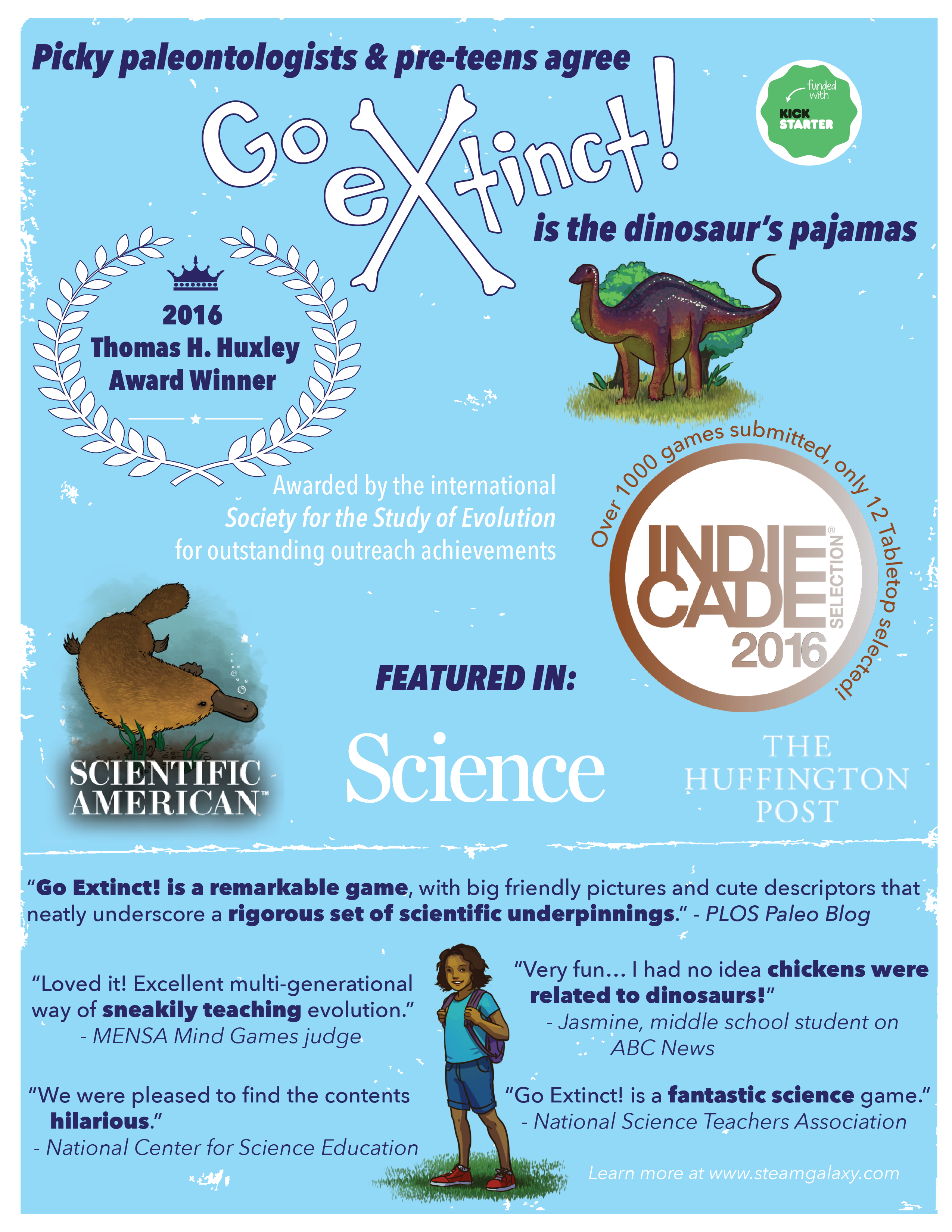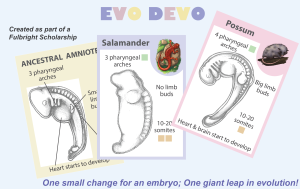
Go Extinct! and the Next Gen Science Standards
You can view, copy, and edit this page for your own classroom use with this Google Drive link.
Executive Summary
Evolutionary trees are one the most important scientific diagrams; they neatly summarize the evolutionary relationships among living things. Go Extinct! is a 30-minute social board game for 3 to 6 players, ages 8 and up. The game incorporates an accurate evolutionary tree of land vertebrates (amphibians, mammals, reptiles and birds) and highlights several lines of evidence used to infer their evolutionary relationships including shared traits, genetics, and geography.
Evolutionary trees are visual representations of the Unity and Diversity of life, the overarching theme of Life Science Topic 4: Biological Evolution. The branches represent diversity; the nodes, where branches converge, represent common ancestors. Common characteristics unify all of the animals whose branches connect to a particular node.
By playing Go Extinct! — a game based on an accurate evolutionary tree emphasizing common characteristics of vertebrates — students will directly explore:
- the Science and Engineering Practice that scientists look for patterns and order when making observations about the world,
- the Disciplinary Core Idea LS4.A: Evidence of Common Ancestry and Diversity, and
- the Crosscutting Concept of using graphs, charts, and images to identify patterns.
Specific standards incorporated by gameplay: HS-LS4-1, MS-LS4-1 and -2, and LS-LS4-2.
In class discussions, Go Extinct! can launch an investigation on how certain adaptations allowed groups of animals to become more successful and diverse than others. For example, why water-proof eggs were such an important adaptation for land vertebrates.
Adaptation is Disciplinary Core Idea LS4.C.
- In High School, this facilitates the transition from standards HS-LS4-1 through 4 on evolution at a population level and introduce the HS-LS4-5 on patterns of evolution at the species level and causes of extinction.
- In Middle School, this puts a species-level perspective on MS-LS4-4: how certain traits increase some individual’s probability of surviving and reproducing in a specific environment.
In context with related standards: Go Extinct! emphasizes different developmental strategies (e.g. eggs, pouches, and long pregnancies). Therefore it can provide an accessible transition from investigating physical traits as evidence for evolution to embryonic development as evidence for evolution. This specifically supports standards HS-LS4-1 and MS-LS4-3.
For more ideas on how to incorporate Go Extinct! into your curricula and the exact wording of standards cited here, please read the explanation in the following pages of this document.
All of the Next Generation Science Standards on evolution can be found at the following links for High School, Middle School, and Grade School.
PLAYING THE GAME & NGSS
By virtue of its design, gameplay and the information on the evolutionary tree board / animal cards will help students understand the following standards on their own and can be expanded upon with teacher guidance:
| HS-LS4-1. | Communicate scientific information that common ancestry and biological evolution are supported by multiple lines of empirical evidence. [Clarification Statement: Emphasis is on a conceptual understanding of the role each line of evidence has relating to common ancestry and biological evolution. Examples of evidence could include similarities in DNA sequences, anatomical structures, and order of appearance of structures in embryological development.] |
| MS-LS4-1. | Analyze and interpret data for patterns in the fossil record that document the existence, diversity, extinction, and change of life forms throughout the history of life on Earth under the assumption that natural laws operate today as in the past. [Clarification Statement: Emphasis is on finding patterns of changes in the level of complexity of anatomical structures in organisms and the chronological order of fossil appearance in the rock layers.] [Assessment Boundary: Assessment does not include the names of individual species or geological eras in the fossil record.]
LS4.A: Evidence of Common Ancestry and Diversity |
| MS-LS4-2. | Apply scientific ideas to construct an explanation for the anatomical similarities and differences among modern organisms and between modern and fossil organisms to infer evolutionary relationships. [Clarification Statement: Emphasis is on explanations of the evolutionary relationships among organisms in terms of similarity or differences of the gross appearance of anatomical structures.]
Patterns |
Go Extinct! emphasizes the common physical traits (such as bone structures, ability to lose a tail, or maintaining constant body temperature), how an embryo develops (in an egg, in a pouch, or in a long pregnancy), DNA sequence similarity, and geographic origins of each group of animals. The organization of these traits on the tree demonstrates how scientists classify animals in the tree by determining how closely or distantly two animals are related based on multiple lines of evidence. Learn more here.
| 2-LS4-1. | Make observations of plants and animals to compare the diversity of life in different habitats. [Clarification Statement: Emphasis is on the diversity of living things in each of a variety of different habitats.] [Assessment Boundary: Assessment does not include specific animal and plant names in specific habitats.]
Scientific Knowledge is Based on Empirical Evidence
|
Go Extinct! features a wide diversity of animals from all over the world. The game is particularly good at emphasizing patterns among animals – even those widespread. For example, the game demonstrates that bats, lions, horses, and whales are known to be closely related because their fossil origins are all found on the same ancient continent.
CLASS DISCUSSIONS OF THE GAME & NGSS
Furthermore, Go Extinct! can launch an investigation into how certain adaptations allowed groups of animals to become more successful and diverse than others. Understanding this central concept helps prevent and unravel common misconceptions about evolution because it relates our understanding of evolution on a population-level (traits that improve an individual’s ability to reproduce persist) to larger patterns of species diversity.
For example, the evolution of the water-proof eggshell in the Amniote group of animals (called “Shell Shockers” in the game) was an important adaptation that helped a population of 4-legged fish descendents transition from an aquatic environment to living on land. Shells that protect embryos from drying out allowed Amniotes to reach a shockingly higher level of diversity than their Amphibian counterparts because they could reproduce in more types of environments. Amphibians (called Slimeballs in the game) retained the ancestral trait of eggs that need to be wet in order to survive (hence the nickname) and are thus restricted to moist environments or areas where at least seasonal ponds exist.
In High School, this key point would facilitate the transition from standards HS-LS4-1 through 4 on evolution at a population level and introduce the following standard:
| HS-LS4-5. | Evaluate the evidence supporting claims that changes in environmental conditions may result in: (1) increases in the number of individuals of some species, (2) the emergence of new species over time, and (3) the extinction of other species. [Clarification Statement: Emphasis is on determining cause and effect relationships for how changes to the environment such as deforestation, fishing, application of fertilizers, drought, flood, and the rate of change of the environment affect distribution or disappearance of traits in species.] |
In Middle School, it puts the following standard in context of larger species diversity patterns:
| MS-LS4-4. | Construct an explanation based on evidence that describes how genetic variations of traits in a population increase some individuals’ probability of surviving and reproducing in a specific environment. [Clarification Statement: Emphasis is on using simple probability statements and proportional reasoning to construct explanations.] |
THE GAME IN CONTEXT WITH RELATED NEXT GEN SCI STANDARDS
Go Extinct! provides a transition from the evolution of physical traits to how evolution is reflected in embryonic development. This is another major line of evidence supporting evolution and evolutionary relationships among animals.
For example, while Amniotes are defined by the type of eggs they lay, live-birth-giving mammals (Therians, called Birth Givers in the game) are still considered Amniotes. Teachers can compare the membranes within the Amniotic egg to the analogous membranes surrounding the developing embryo in pregnant mammals, such as the amnion, chorion, and placenta. In biology, “analogous” means the structures in pregnant mammals evolved directly from the structures in amniotic eggs.
Furthermore, similar to the discussion of Amphibians versus Amniotes, teachers can draw attention to the immense diversity among placental mammals versus monotreme and marsupial mammals. Placental mammals (called “Big Babies” in the game), have much longer pregnancies and give birth to more highly developed young. A longer pregnancy provides a longer time period in which the baby is not submitted to environmental selection pressures, which in turn allows evolution more time and ability to “tinker with” and produce more variation in the basic body plan of placental mammals.
In High School, this discussion can provide another lens to investigate the following standard:
| HS-LS4-1. | Communicate scientific information that common ancestry and biological evolution are supported by multiple lines of empirical evidence. [Clarification Statement: Emphasis is on a conceptual understanding of the role each line of evidence has relating to common ancestry and biological evolution. Examples of evidence could include similarities in DNA sequences, anatomical structures, and order of appearance of structures in embryological development.] |
In Middle School, this discussion places the following standard in context within the overarching unit on the unity and diversity of life:
| MS-LS4-3. | Analyze displays of pictorial data to compare patterns of similarities in the embryological development across multiple species to identify relationships not evident in the fully formed anatomy. [Clarification Statement: Emphasis is on inferring general patterns of relatedness among embryos of different organisms by comparing the macroscopic appearance of diagrams or pictures.] [Assessment Boundary: Assessment of comparisons is limited to gross appearance of anatomical structures in embryological development.] |
***
Sample Investigation Questions
- Based on what we learned about evolutionary trees, why are mice such good laboratory subjects for studying human disease?
- Based on what we learned about amniotic eggs providing a key adaptation to land, can you identify or hypothesize other adaptations that allowed tetrapods to survive or reproduce more efficiently on land?



